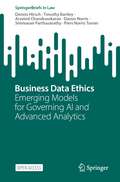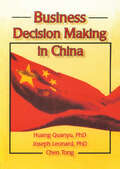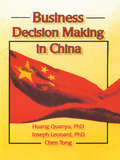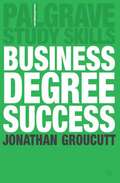- Table View
- List View
Business Czarinas
by S N CharyBusiness Czarinas features some of the most successful businesswomen in India. Each of their stories is greatly inspiring: their journey to the top; the troubles and obstacles on the way; the opportunities they made the most of; the values they hold dear and the lessons they learnt. Management consultant S.N. Chary interviews nine remarkable women leaders, giving us insight into their work and life. In Business Czarinas these women tell us how they fought-at times for space, in a male-dominated environment-against all odds, with courage and strength. Candid, enlightening and full of practical, first-hand wisdom, these powerful stories make this book essential reading for both men and women.
Business Darwinism: Adaptive Strategies for the Information Age
by Eric A. MarksThe survival of the fastest Information technology is now essential to business evolution. Companies that invest in IT as a future resource will live to see the future. The rest won't. The hard reality of the new "Information Darwinism," a term coined by author Eric Marks, is brilliantly and provocatively described in e-Darwinism, a look at the make-or-break impact of IT on accelerating the global struggle for market share. The book offers a compelling look at just how the Internet has transformed business strategy and business strategy creation, IT strategy, and manufacturing strategy for manufacturing and service firms, and made significant inroads in driving revenue enhancement and cost savings as well as reducing a firm's time to market. The book also describes how much the ability to leverage IT has become a requirement for measuring-and selecting-future leaders.
Business Dashboards: A Visual Catalog for Design and Deployment
by Nils H. Rasmussen Manish Bansal Claire Y. ChenFocusing on designing the right dashboards for use in an organization, this timely, full color book reveals how to successfully deploy dashboards by building the optimal software architecture and dashboard design. In addition, it describes the value of this popular technology to a business and how it can have a significant impact on performance improvement. A unique collection of more than 120 dashboard images are organized by category. One of the chapters provides a step-by-step description of the key performance indicator (KPIs) design process. One of the appendices contains more than 1,000 examples of KPIs to help design the content of dashboards. The book also describes all the steps in a dashboard implementation and offers related advice. Nils Rasmussen (West Hollywood, CA) is cofounder and Principal of Solver, Inc. Claire Y. Chen (Long Beach, CA) is a Senior Business Intelligence Architect at Solver, Inc. Manish Bansal (Irvine, CA) is Vice President of Sales at Solver, Inc.
Business Dashboards: A Visual Catalog for Design and Deployment
by Nils H. Rasmussen Manish Bansal Claire Y. ChenFocusing on designing the right dashboards for use in an organization, this timely, full color book reveals how to successfully deploy dashboards by building the optimal software architecture and dashboard design. In addition, it describes the value of this popular technology to a business and how it can have a significant impact on performance improvement. A unique collection of more than 120 dashboard images are organized by category. One of the chapters provides a step-by-step description of the key performance indicator (KPIs) design process. One of the appendices contains more than 1,000 examples of KPIs to help design the content of dashboards. The book also describes all the steps in a dashboard implementation and offers related advice. Nils Rasmussen (West Hollywood, CA) is cofounder and Principal of Solver, Inc. Claire Y. Chen (Long Beach, CA) is a Senior Business Intelligence Architect at Solver, Inc. Manish Bansal (Irvine, CA) is Vice President of Sales at Solver, Inc.
Business Data Analysis Using Excel: (pdf)
by David WhighamTaking a thematic approach to the use of Excel spreadsheets in introductory business data analysis, this text has been designed to explain the overall nature of what is to be achieved and also instruction in how it is to be done. The learning approach is highly interactive and enables students to develop an understanding of the power of Excel in allowing both analysis of business data sets and in the flexible preparation of graphs, charts and tables for inclusion in reports and essays. The text is supported by an online resource center with self-marking exercises that can be used by instructors for formative and summative assessment, and a series of PowerPoint files containing all of the illustrated worksheets and figures.
Business Data Ethics: Emerging Models for Governing AI and Advanced Analytics (SpringerBriefs in Law)
by Dennis Hirsch Timothy Bartley Aravind Chandrasekaran Davon Norris Srinivasan Parthasarathy Piers Norris TurnerThis open access book explains how leading business organizations attempt to achieve the responsible and ethical use of artificial intelligence (AI) and other advanced information technologies. These technologies can produce tremendous insights and benefits. But they can also invade privacy, perpetuate bias, and otherwise injure people and society. To use these technologies successfully, organizations need to implement them responsibly and ethically. The question is: how to do this? Data ethics management, and this book, provide some answers. The authors interviewed and surveyed data ethics managers at leading companies. They asked why these experts see data ethics as important and how they seek to achieve it. This book conveys the results of that research on a concise, accessible way. Much of the existing writing on data and AI ethics focuses either on macro-level ethical principles, or on micro-level product design and tooling. The interviews showed that companies need a third component: data ethics management. This third element consists of the management structures, processes, training and substantive benchmarks that companies use to operationalize their high-level ethical principles and to guide and hold accountable their developers. Data ethics management is the connective tissue makes ethical principles real. It is the focus of this book. This book should be of use to organizations that wish to improve their own data ethics management efforts, legislators and policymakers who hope to build on existing management practices, scholars who study beyond compliance business behavior, and members of the public who want to understand better the threats that AI poses and how to reduce them.
Business Decision Making in China
by Huang Quanyu Chen Tong Joseph W LeonardKnowledgeable decision making not only saves you time, money, and effort, but also leads you to extra opportunities. Business Decision Making in China improves your business acumen by showing you who (in itals) is involved in business decision making, how (in itals) decisions have been made, what (in itals) the characteristics and strategies of Chinese decision making are, and why (in itals) decision making has followed certain patterns in China. Practitioners, consultants, and government officials who are involved in business with China as well as academicians researching or teaching about business in East Asia will find this book to be an invaluable resource. Business Decision Making in China introduces you to such subjects as Chinese organizational structures and relationships, tactics of decision making, and traditional Chinese culture. Other vital topics you learn about include: the pros and cons of joint venture enterprises in China the climate for foreign banks operating in China the importance of saving face the concept of “the golden mean” the unity of opposites (Yin-Yang) the 4 realms of Chinese managers’daily affairs modes of thinking (universality versus individuality, thinking in images, understanding abstract thoughts) the parallels between the 5 elements (metal, wood, water, fire, earth) and the 4 P’s (product, price, promotion, place)As a guidebook for Chinese business, Business Decision Making in China addresses the broad and integrative discipline of decision making and helps Western business people (who have an entirely different set of patterns, styles, processes, philosophical thoughts, and tactics of decision making) to adapt to their Chinese business partners’or opponents’decision making. Since this book explains the profound process of Chinese decision making in uncomplicated terms and practical business experiences, readers will be able to apply their new knowledge to their long-range strategic planning, to skillfully solving their daily problems or questions, and to wisely avoiding losses from a multitude of potential pitfalls.
Business Decision Making in China
by Huang Quanyu Chen Tong Joseph W LeonardKnowledgeable decision making not only saves you time, money, and effort, but also leads you to extra opportunities. Business Decision Making in China improves your business acumen by showing you who (in itals) is involved in business decision making, how (in itals) decisions have been made, what (in itals) the characteristics and strategies of Chinese decision making are, and why (in itals) decision making has followed certain patterns in China. Practitioners, consultants, and government officials who are involved in business with China as well as academicians researching or teaching about business in East Asia will find this book to be an invaluable resource. Business Decision Making in China introduces you to such subjects as Chinese organizational structures and relationships, tactics of decision making, and traditional Chinese culture. Other vital topics you learn about include: the pros and cons of joint venture enterprises in China the climate for foreign banks operating in China the importance of saving face the concept of “the golden mean” the unity of opposites (Yin-Yang) the 4 realms of Chinese managers’daily affairs modes of thinking (universality versus individuality, thinking in images, understanding abstract thoughts) the parallels between the 5 elements (metal, wood, water, fire, earth) and the 4 P’s (product, price, promotion, place)As a guidebook for Chinese business, Business Decision Making in China addresses the broad and integrative discipline of decision making and helps Western business people (who have an entirely different set of patterns, styles, processes, philosophical thoughts, and tactics of decision making) to adapt to their Chinese business partners’or opponents’decision making. Since this book explains the profound process of Chinese decision making in uncomplicated terms and practical business experiences, readers will be able to apply their new knowledge to their long-range strategic planning, to skillfully solving their daily problems or questions, and to wisely avoiding losses from a multitude of potential pitfalls.
Business Decisions, Human Choices: Restoring the Partnership Between People and Their Organizations (Non-ser.)
by Lloyd C. WilliamsDr. Williams contends that over the last 20 years a change has occurred in organizations that has created a syndrome of dysfunctions that are neither good for businesses nor for the people who work in them. Williams sees businesses as living entities, and argues that how they act and react will have an impact on their employees, and often a devastating impact. In much the same way as businesses make decisions, people make choices, and seldom are these decisions and choices congruent. Unless disparate self-interests and goals can be reconciled—unless a partnership can be restored between people and their organizations—not only will employees be damaged, but the success of their organization, upon which they depend for their livelihoods, will be jeopardized. How this dangerous situation came about, what it means, and how it can be remedied is the subjet of Dr. Williams' book. Research-based and always in touch with the realities of commerce, Dr. Williams will make business people aware that organizations and their people must become reunited, and then show them how it can be done.Dr. Williams makes clear he is not simply speculating or theorizing. His goal is to make management aware of the dysfunctions that are damaging their organizations, and how these are reflected in the behaviors of their employees. When he calls for a focus on humanity, spirit, and context, Dr. Williams is actually offering a workable, real-world strategy to breathe new life into organizations of all kinds—a strategy he calls The Trinity Process. Its purpose: to help management restore the essential partnership between organizational entities and the people who make them succeed or fail. In Part One he shows what it means to be part of any organization and, with anecdotes and cases from his own research, helps readers grasp the dynamics of their own organizations. In Part Two he proposes new or reframed paradigms that provide an underpinning for the reestablishment of equality between organizations and their employees. Then, in Part Three he presents The Trinity Process itself. The result is a remarkably lucid, readable, engrossing exploration of organizational life today, important reading for decision makers in all types of organizations, public as well as private, and for academics concerned with how organizations behave.
Business Degree Success (PDF)
by Jonathan GroucuttThis is a practical guide for those studying business and management-related subjects at undergraduate level. Written in an engaging and clear style, the book helps students prepare effectively for assignments, presentations, examinations and dissertations, encompassing both business studies and the real workings of business.
Business Design Thinking and Doing: Frameworks, Strategies and Techniques for Sustainable Innovation
by Angèle M. BeausoleilThis textbook aims to guide, instruct and inspire the next generation of innovation designers, managers and leaders. Building upon an evidence-based innovation development process, it introduces, explains and provides visual models and case examples of what Business Design is, how it is applied across sectors and organizations, and its impact on decision-making and value creation.Students will read and analyze design-led innovation business cases from across the globe, discover multi-disciplinary strategies (from marketing to anthropology) and practice applying a designer’s toolkit to find, frame, and solve business problems in contemporary ways. Throughout the book, students will break down the process of innovation and move from initiation to implementation, engage in iterative feedback loops, and develop concrete plans for personal and professional collaboration and workplace application.For MBA and senior undergraduate students, this book offers a step-by-step and comprehensive reference guide to creative problem framing and solving – inside and beyond the classroom. It integrates marketing principles and management frameworks, with anthropological and design methods reflecting the diverse and in-demand skills vital to tomorrow’s workforce.For instructors, this book offers a way to confidently engage learners in the realm of design practices and strategies relevant to business decision-making. The pedagogical framework, along with a comprehensive suite of techniques and templates, offers both novice and experienced teachers a step-by-step reference guide that facilitates skills development in creative problem framing and solving.
Business Despite Borders: Companies in the Age of Populist Anti-Globalization
by Santiago Iñiguez de Onzoño Kazuo IchijoGlobalization has been a key force in the development of business in recent decades. But with nationalism on the rise in Europe, the United States and elsewhere, the future of global trade and international business has been thrown into doubt. In this new and challenging context, innovative companies have the opportunity not only to find new ways to operate across borders, but also to help forge a new system of relations between people of different nationalities and cultures. This book features a collection of case studies that illustrate how companies from different corners of the globe are succeeding in reaching out to distant customers, stakeholders and partners. It features inspiring examples of leaders who are actively developing imaginative ways to connect across continents. It is a vital reference tool for companies that plan to continue operating globally or to expand their international presence. A clarion call for the renewed relevance and importance of globalized business, this book suggests a future where companies can contribute positively to achieving sustainable growth and a fairer distribution of wealth across the globe.
Business Despite Borders: Companies in the Age of Populist Anti-Globalization
by Santiago Iñiguez de Onzoño Kazuo IchijoGlobalization has been a key force in the development of business in recent decades. But with nationalism on the rise in Europe, the United States and elsewhere, the future of global trade and international business has been thrown into doubt. In this new and challenging context, innovative companies have the opportunity not only to find new ways to operate across borders, but also to help forge a new system of relations between people of different nationalities and cultures. This book features a collection of case studies that illustrate how companies from different corners of the globe are succeeding in reaching out to distant customers, stakeholders and partners. It features inspiring examples of leaders who are actively developing imaginative ways to connect across continents. It is a vital reference tool for companies that plan to continue operating globally or to expand their international presence. A clarion call for the renewed relevance and importance of globalized business, this book suggests a future where companies can contribute positively to achieving sustainable growth and a fairer distribution of wealth across the globe.
The Business Developer's Playbook: Relationship Selling Principles and the DNA of Dialogue Selling
by Peter NixonThis book is not about selling products -- it is about selling yourself, your ideas, and your services. This book explains an innovative dialogue sales process, and the relationship sales principles that underpin it. In every sales situation, there is both a seller and a buyer and, at different times, either the buyer or the seller may take the lead. The dance they perform may or may not lead to a deal, but it will leave them knowing a little more about each other’s strengths and weaknesses. These two dancers are "connected" and follow the same steps -- The five steps they follow are to plan, connect, dialogue, record, and follow up. The five steps are the basis of the dialogue process. In addition, this book provides easy-to-follow guidance for three groups of people: 1. Professionals wanting to sell their services and improve their business development; 2. Thought leaders, change agents, innovators, entrepreneurs, senior public servants, and advocates wanting to sell their ideas to others; 3. Mid-career job seekers and recent graduates aiming to sell themselves into a dream job role either full or part-time.
The Business Developer's Playbook: Relationship Selling Principles and the DNA of Dialogue Selling
by Peter NixonThis book is not about selling products -- it is about selling yourself, your ideas, and your services. This book explains an innovative dialogue sales process, and the relationship sales principles that underpin it. In every sales situation, there is both a seller and a buyer and, at different times, either the buyer or the seller may take the lead. The dance they perform may or may not lead to a deal, but it will leave them knowing a little more about each other’s strengths and weaknesses. These two dancers are "connected" and follow the same steps -- The five steps they follow are to plan, connect, dialogue, record, and follow up. The five steps are the basis of the dialogue process. In addition, this book provides easy-to-follow guidance for three groups of people: 1. Professionals wanting to sell their services and improve their business development; 2. Thought leaders, change agents, innovators, entrepreneurs, senior public servants, and advocates wanting to sell their ideas to others; 3. Mid-career job seekers and recent graduates aiming to sell themselves into a dream job role either full or part-time.
Business Development: A Guide To Small Business Strategy
by David Butler'Business Development' provides a readable and practical book for the growth and development of businesses. This is primarily a textbook for the NVQ4 Business Development qualification, the Institute of Management Certificate in Owner Management courses, and HND Small business modules, but the text is also an invaluable practical guide to owner-managers of small businesses. All businesses pass through several stages of growth and it occurs for a number of reasons, such as change in the commercial market, increased customer demand for services or product, higher numbers of customers. Business Development shows how to make the most of this growth and also how to deal with the different types of problems that are encountered along the way. The book is structured to follow a logical sequence of questions that makes it readily accessible: Where are we now? Where do we want to go? What resources are needed to get there? What sales and marketing policies do we need to develop? It examines the personnel and staffing implications, the efficiency of the current financial management process, and the owner's own abilities to make it all happen. Most important of all it makes the owner-manager takes a long, hard look at the business and where it is really going.
Business Development: Customer-oriented Business Development for successful companies
by Andreas KohneThe book provides a compact overview of the increasingly important topic of Business Development (BD). The author not only describes the role of the Business Development Manager and its tasks, but also shows how Business Development can be integrated organizationally into a company. In addition, a prototypical Business Development Process is presented in concrete terms and explained using a case study. The book shows why enterprises fail, deals with new creative techniques such as Hackthons and dedicates itself more comprehensively than so far to the topic of communication in the course of changes.The book helps all, which want to introduce and/or optimize Business Development in the enterprise as responsible ones or work in the future in this range.
Business Development: Kundenorientierte Geschäftsfeldentwicklung für erfolgreiche Unternehmen
by Andreas KohneDas Buch gibt einen kompakten Überblick über das immer wichtiger werdende Thema Business Development (BD). Dazu beschreibt der Autor nicht nur die Rolle des Business Development Managers mit ihren Aufgaben, sondern er zeigt auch, wie Business Development organisatorisch in eine Firma integriert werden kann. Darüber hinaus wird ein prototypischer Business Development Prozess konkret vorgestellt und anhand einer Fallstudie erläutert.Das Fachbuch hilft allen, die als Verantwortliche Business Development im Unternehmen einführen bzw. optimieren wollen oder zukünftig in diesem Bereich arbeiten.
Business Development: Kundenorientierte Geschäftsfeldentwicklung für erfolgreiche Unternehmen
by Andreas KohneDas Buch gibt einen kompakten Überblick über das immer wichtiger werdende Thema Business Development (BD). Dazu beschreibt der Autor nicht nur die Rolle des Business Development Managers mit ihren Aufgaben, sondern er zeigt auch, wie Business Development organisatorisch in eine Firma integriert werden kann. Darüber hinaus wird ein prototypischer Business Development-Prozess konkret vorgestellt und anhand einer Fallstudie erläutert.Das Fachbuch hilft allen, die als Verantwortliche Business Development im Unternehmen einführen bzw. optimieren wollen oder zukünftig in diesem Bereich arbeiten.
Business Development: Prozesse, Methoden und Werkzeuge
by Andreas KohneDas Fachbuch gibt einen kompakten Überblick über das immer wichtiger werdende Thema Business Development. Dazu beschreibt der Autor nicht nur die Rolle des Business Development Managers mit ihren Aufgaben, sondern er zeigt auch, wie Business Development organisatorisch in eine Firma integriert werden kann. Darüber hinaus wird ein prototypischer Business Development Prozess konkret vorgestellt und anhand einer Fallstudie erläutert.Die dritte, überarbeitete und erweiterte Auflage des Fachbuches zeigt, dass Krisen auch eine Chance sein können, erläutert spezifische Key Performance Indicators (KPIs) für Business Development und beschreibt neue digitale Geschäftsmodelle. Zusätzlich wurde das Buch um ein praxisnahes Interview und um Stimmen aus Wirtschaft und Wissenschaft ergänzt.Das Fachbuch hilft allen, die als Verantwortliche Business Development im Unternehmen einführen bzw. optimieren oder zukünftig in diesem Bereich arbeiten wollen.
Business Development: Processes, Methods and Tools
by Andreas KohneThis reference book provides a compact overview of the increasingly important topic of Business Development. The author not only describes the role of the Business Development Manager with its tasks, but also shows how Business Development can be organizationally integrated into a company. In addition, a prototypical Business Development Process is specifically presented and explained using a case study.The second, revised and expanded edition of the reference book shows that crises can also be an opportunity, explains specific Key Performance Indicators (KPIs) for Business Development and describes new digital business models. In addition, the book was supplemented by a practical interview and quotes from business and science.The reference book helps everyone who is responsible for introducing or optimizing Business Development in the company or who wants to work in this area in the future.
Business Development: A Market-Oriented Perspective
by Hans Eibe SørensenThis textbook answers the basic questions: "What is business development?" "What does the business developer do?" and "What characterises good, structured, effective business development?" Distinguishing business development and the tasks of the business developer from traditional approaches of strategic management, entrepreneurship, and strategic marketing, this textbook will enable the market-oriented business developer to conceive, craft, and implement superior business plans. The book is divided into three modules focusing on the market-oriented business developer’s mindset, on providing a state-of-the-art toolbox for careful strategic analyses and decisions, and lastly on the critical aspects of business plans and their content. The approach of the book is focused and selective in its choice of content and provides a cumulative development of the relevant topics. Each chapter includes an ‘implications for the market-oriented business developer’ at the end to enhance a student’s learning. The content of the book is applicable to any new business venture as well as for the development and implementation of growth opportunities in mature organizations. Inherently international in its scope, the text includes numerous real world examples, taken from the author’s own experience as a biotech entrepreneur, as well as from the wider global business community.
Business Development and Economic Governance in Southeastern Europe: 13th International Conference on the Economies of the Balkan and Eastern European Countries (EBEEC), Pafos, Cyprus, 2021 (Springer Proceedings in Business and Economics)
by Pantelis Sklias Persefoni Polychronidou Anastasios Karasavvoglou Victoria Pistikou Nikolaos ApostolopoulosThis book addresses contemporary and modern topics around business growth and economic development in Southeastern Europe. It covers a wide range of business issues focusing on the adoption of new technologies, finance of SMEs, place marketing, value co-creation, contribution to economic growth, and internationalization. Moverover, it sheds new light on the micro- and macroeconomic developments and monetary policy issues in the Eastern European and Balkan countries. This book is a useful tool for scholars in economics and finance interested in the further economic development of the Balkans and Eastern European countries as well as to professionals in the business, financial and insurance sectors.





















